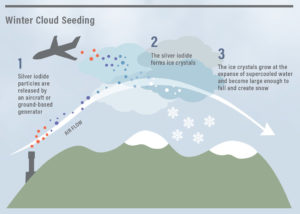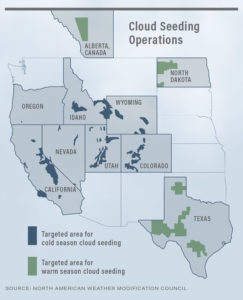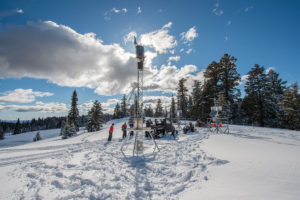Are you hungry for more powder days off the top of Baldy?
Are you tired of watching Jackson Hole’s winter reports dumping snow? Are you fed up with the lack of late-season irrigation water to get your last cutting of alfalfa?
Or is the Big Wood River running at a trickle by late August? Or, do you appreciate that your power bill has remained one of the cheapest in the United States as seemingly all other raw materials have inflated over the past year?
Whichever you may be, many Idahoans do not realize planes and generators are scattering the entire state, emitting natural chemicals into the air. The reason? You guessed it, to create more snow.
These aren’t the tall yellow snow guns on the left side of ski runs that young kids use as jumps. No, this is a highly scientific program of collaborative professionals who are chemically amending the natural atmospheric systems to increase snowpack. And it’s happening in your backyard.
What is cloud seeding?
Cloud seeding is a process that introduces additional ice nuclei—or silver iodide (Agl)—into the air at purposeful locations, temperatures, and times of the year. The addition of the silver iodide allows the atmospheric water held as moisture to begin the ice formation process at higher temperatures.
 As a quick reminder for those who fell asleep in high school environmental science class, clouds contain large quantities of water in a liquid state. For the water to freeze, it must reach a low enough temperature (often minus 32 degrees F) to crystallize. The snowflake formation process must include the nuclei—or core—
As a quick reminder for those who fell asleep in high school environmental science class, clouds contain large quantities of water in a liquid state. For the water to freeze, it must reach a low enough temperature (often minus 32 degrees F) to crystallize. The snowflake formation process must include the nuclei—or core—
for the liquid water to form around.
With the cloud-seeding process, the chemical compound provides the nuclei on which water can condense, forming water droplets and/or ice crystals.
In other words, the addition of inorganic chemicals increases the temperature at which precipitation can occur.
“Otherwise, most winter storms are inefficient, with water vapor transitioning downwind and not producing snowfall on the ground,” said Idaho Power’s senior atmospheric scientist Derek Blestrud in a 2022 interview with the
Argus Observer.
Basically, cloud seeding is the process of teaching clouds to form snow.
What’s New?
This process is not unique to Idaho. Data from the World Meteorological Organization (2000) listed 74 projects across 23 countries worldwide. In 2001, the National Oceanic and Atmospheric Administration (NOAA) documented 66 projects in the Western United States alone. A wide range of stakeholders is currently interested in cloud-seeding programs across the U.S. These include municipal, county and state governments; irrigation, water resource and water conservation districts; airports; ski resorts; and private industry. There are currently active programs across several states, including Idaho, North Dakota, California, Texas, Colorado, Wyoming, Utah, Nevada and Alberta, Canada.
One of the largest, most robust programs is here in Idaho—funded by Idaho Power.
According to its website, Idaho Power’s goal is to supply added water for Idaho Power’s hydropower projects, which provide reliable, inexpensive and clean energy. Increased snowpack benefits irrigation, winter sports, clean river usage and Idaho Department of Fish & Game.

An aircraft flies into the clouds carrying flares filled with silver iodide to be released into clouds in order to create more snow.
The Idaho Power cloud seeding program has a rich, colorful history. At the request of stakeholders, the quest initially began to investigate the effectiveness of cloud seeding in 1993. After a four-year literature review and climatology study, Idaho Power contracted its first operational program during the 1996-1997 winter.
The program was suspended for a short period and only to be reinstated in February of 2003. The program focused on snow accumulation in the south and middle forks of the Payette River watershed. In 2008, Idaho Power expanded its efforts by enhancing a program operated by a group of counties and other stakeholders in the upper Snake River system above Milner Dam.
As a result, the program now includes a robust system of multiple techniques across multiple state regions.
Idaho Power operates remote-controlled, ground-based generators and aircraft to target the Payette, Boise and Wood River basins, and the upper Snake River systems. In the central mountains (Payette, Boise and Wood River basins), the Idaho Power program runs 32 remote ground-based generators and two airplanes. Idaho Power also operates the upper Snake River basin program in conjunction with the High Country Resource Conservation and Development program that includes 25 remote ground-based, 25 manual ground-based generators and one airplane.
Both methods mentioned above release silver iodide into passing storms, which allows the water particles to freeze in contact with the silver iodide particles. And that allows more precipitation to fall to the ground as snow.
Does it Work?
Now, before you turn the page and think this is all hocus pocus, the program’s results have been incredible. Analyses conducted by Idaho Power since 2003 indicate the annual snowpack in the Payette River Basin has increased by an average of approximately 12%. In addition, Idaho Power has developed a target-control analysis methodology, which evaluates the average benefits in basins with cloud-seeding operations compared to basins without the
programs enacted.
 According to its website, Idaho Power estimates the cloud-seeding programs provide approximately 600,000 acre-feet of additional water in the Payette, Boise and Wood River basins and 400,000 acre-feet of extra water in the upper Snake River basin. The combined one million acre-feet can generate approximately 844,500 megawatt-hours if used for hydroelectric production—enough to power roughly 74,000 homes.
According to its website, Idaho Power estimates the cloud-seeding programs provide approximately 600,000 acre-feet of additional water in the Payette, Boise and Wood River basins and 400,000 acre-feet of extra water in the upper Snake River basin. The combined one million acre-feet can generate approximately 844,500 megawatt-hours if used for hydroelectric production—enough to power roughly 74,000 homes.
Are there Negative ramifications?
Of course, one may wonder, this all sounds great, but how does emitting chemicals into the air affect the environment? Idaho Power has performed extensive global research.
According to a 2014 published scientific report titled “Idaho Power Company’s Cloud Seeding Program” from Shaun Parkinson (Ph.D., P.E.), the results show no environmentally harmful effects arising from cloud seeding with silver iodide aerosols, nor would they be expected to occur. Based on this work, the Weather Modification Association (WMA) finds that silver iodide is environmentally safe as it is currently being dispensed during cloud-seeding programs.
The Idaho Department of Environmental Quality also has researched the effects on water quality in the basins. The findings report “it is unlikely that cloud seeding will cause a detectable increase in silver concentrations in target areas or pose a chronic effect to sensitive aquatic organisms.” In addition, the amount of silver iodide emitted into the air is at such low volumes that an air quality permit is not needed based on
screening thresholds.
Is Idaho going all in?
So, what does the future hold? It appears the Idaho State Legislature has already made up its mind. In 2021, House Bill 266 was signed into law, stimulating further activity and promoting more cloud-seeding opportunities across the state. The Legislature describes the program as a “unique and innovative opportunity to augment and sustain the water resources of the state.”

Idaho Power’s Garden Mountain cloud seeding and meteorological site in the Payette River Basin.
There are many other vested stakeholders besides Idaho Power and powder-loving enthusiasts. For example, Paul Arrington, the executive director and general counsel for the Idaho Water Users Association (IWUA), has a keen interest in the cloud-seeding programs to augment the water supply for Idaho’s greatest economic
industry—agriculture.
The IWUA represents groundwater districts and canal companies throughout the state that are heavily reliant on winter storms, increased precipitation, and greater winter snowpacks to extend the late summer irrigation season.
Arrington stated in an interview with the Idaho State Journal in 2021, “We were skeptical at first, but most if not all of us have come around to understanding and appreciating that cloud seeding is a valuable tool to help sustain and shore up water supplies—like an arrow in your quiver, so to speak.”
Whether you agree or disagree with the environmental ramifications, or the ethical pontifications of humans trying to play God, or are unconvinced of the scientific evidence on the effectiveness, we can all agree on one thing—we need more water.
For now, the State of Idaho sees the program as one part of the solution.
Want More Info?
If you would like to conduct your own research on cloud seeding programs, please visit the links below for more information:
North American
Weather Modification Council —nawmc.org
Weather Modification Association — weathermodification.org
Idaho Power — idahopower.com/snow


